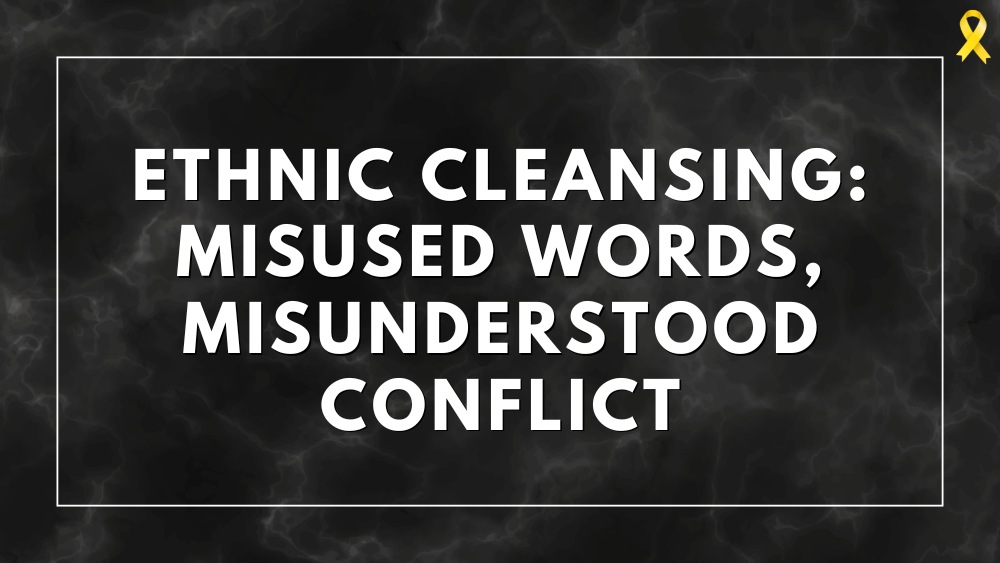
By HFI staff
Ethnic cleansing is a term that evokes images of mass violence, forced migrations, and the systematic removal of entire populations based on their ethnicity, religion, or race by violent or coercive means. It can include forced displacement, mass killings, the destruction of communities, and other forms of persecution aimed at making a region ethnically homogeneous. While genocide focuses on the total eradication of a people, ethnic cleansing primarily targets the removal of that group from a territory. It is a violent effort to change the demographic composition of a region, often driven by political, national, or ideological motives.
Although the term gained significant prominence during the Bosnian War in the 1990s, instances of ethnic cleansing have occurred throughout history. These campaigns have often been part of larger efforts to establish homogeneous states or territories, driven by ideologies that reject the existence of diverse communities.
The term is frequently misused in contemporary discussions, particularly when it comes to conflicts driven by complex political and security dynamics. For example, the ongoing violence in Syria, especially against the Druze community, provides a stark and undeniable example of ethnic cleansing. There, the Syrian regime has employed systematic methods to forcibly remove or eliminate minority groups in specific areas, aiming to reshape the demographic composition of those regions.
Understanding this context is essential, especially when considering the misuse of the term in modern conflicts. Mislabeling situations like the Israeli-Palestinian conflict as ethnic cleansing distorts the real meaning of the term and weakens efforts to address genuine instances of such violence.
Historical Examples of Ethnic Cleansing
The practice of ethnic cleansing has scarred human history, leaving behind legacies of pain, loss, and displacement. Some of the most infamous examples include:
Stalin's Deportations (1940s) Under Joseph Stalin, the Soviet Union forcibly deported entire ethnic groups, including the Crimean Tatars, Chechens, Ingush, and others, to remote regions of Central Asia. These deportations involved mass suffering, death, and the deliberate uprooting of communities from their ancestral lands. The aim was to eliminate potential resistance and homogenize control, marking one of the clearest examples of state-engineered ethnic cleansing in the 20th century.
The Kurdish Campaigns in Iraq (1980s) During the Anfal campaign, Saddam Hussein's regime carried out mass killings, village destruction, and forced displacements against the Kurdish population in northern Iraq. Tens of thousands were killed, and hundreds of thousands more were displaced in an effort to Arabize the region and crush Kurdish resistance. This state-directed effort to change the demographic character of an entire region is widely recognized as a campaign of ethnic cleansing.
The Bosnian War (1992–1995) The ethnic cleansing of Bosniak Muslims and Croats by Bosnian Serb forces during the Bosnian War provides one of the most modern and recognized examples. Entire villages were destroyed, families were forcibly removed from their homes, and thousands of civilians were killed or subjected to brutal violence, all in an effort to create an ethnically homogenous Serb-dominated state. The targeted violence and the forced expulsion of people from their land defined the Bosnian conflict as a textbook case of ethnic cleansing.
The Rohingya Crisis (2016–Present) In Myanmar, the military's campaign against the Rohingya Muslims in Rakhine State has been labeled as ethnic cleansing by the international community. The forced displacement of over 700,000 Rohingya, along with mass killings, rapes, and the destruction of their villages, constitutes a classic example of an effort to remove an ethnic group from a region. Myanmar's military sought to erase the presence of the Rohingya in the region, a campaign that has drawn widespread condemnation.
Israel’s Approach to Judea, Samaria, and Gaza
In recent years, some have accused Israel of engaging in ethnic cleansing, particularly in relation to its defensive actions in Judea, Samaria, and Gaza. However, these accusations lack a factual or legal basis when examined in context. Understanding the nature of Israel’s actions, as well as the complex reality of the Israeli-Palestinian conflict, is essential to dispelling such claims.
Israel has faced continuous threats from groups such as Hamas and the Palestinian Islamic Jihad, which openly call for the destruction of Israel and its people. Israel has repeatedly expressed its commitment to peace and a two-state solution, wherein both Israelis and Palestinians could coexist peacefully. The aim has been to reach an agreement that allows for Palestinian self-determination while maintaining the security of Israel. These efforts, including negotiations in the past, are part of Israel’s long-term commitment to finding a peaceful resolution, not the systematic expulsion of Palestinians from their land.
No Intent to Displace or Erase Palestinian Identity
Ethnic cleansing is defined by the systematic and intentional removal of a group from a specific area. This is not reflective of Israel's actions, which, despite the ongoing conflict, have not been aimed at removing Palestinians from Gaza or Judea and Samaria. Israel’s primary goal has been to neutralize threats posed by militant groups, particularly Hamas, and not to erase the Palestinian presence in these territories.
While Israel’s military operations in Gaza have been criticized due to civilian casualties, these operations are focused on dismantling terrorist infrastructure that endangers Israeli lives. There is no evidence to suggest that Israel has any policy to forcefully displace Palestinians or erase their identity and culture. In fact, Israel’s security efforts frequently involve coordination with Palestinian authorities, even amid periods of heightened conflict.
Furthermore, despite the challenges posed by ongoing security threats, Israel continues to provide essential services to Palestinians in Gaza and in Judea and Samaria, including food, medical supplies, electricity, and water. These actions demonstrate Israel’s commitment to meeting the humanitarian needs of Palestinians, even while fighting to protect its own citizens. This is a stark contrast to the concept of ethnic cleansing, where an entire population is targeted for removal or destruction. Instead, Israel’s actions aim to safeguard its people while ensuring that Palestinians have access to necessary resources.
In contrast to the state-led demographic purges seen in Iraq, the Balkans, or Stalin’s USSR, Israel’s conduct reflects a security-driven posture rather than a campaign to eliminate a population group.
The Role of Hamas and Other Extremist Groups
The greatest threat to both Palestinians and Israelis comes from groups like Hamas, which controls Gaza and has long advocated for Israel’s destruction. Hamas’s charter explicitly calls for the elimination of the Jewish state, and it has engaged in terror tactics such as suicide bombings, rocket attacks, and the use of civilians as human shields. These actions create an environment where peace is difficult to achieve, and the primary focus of Israel’s security measures is to neutralize Hamas's military capabilities.
Hamas's actions stand in stark contrast to Israel’s stated goals. Israel’s aim is not the destruction of Palestinian communities or the eradication of Palestinian identity, but rather the protection of its citizens from terrorist groups that seek to destroy it. In the context of Israel’s security, military operations are a response to an immediate threat, rather than an effort to displace or eliminate an entire population.
Why Mislabeling Matters
Using terms like “ethnic cleansing” to describe Israel’s actions in Judea, Samaria, and Gaza misrepresents the nature of the conflict. Ethnic cleansing is a calculated, state-sponsored campaign to remove or annihilate a specific group, driven by ideological goals such as territorial expansion. Israel’s actions, on the other hand, are focused on defending its people from terrorism and securing its borders against those who seek its destruction.
Mislabeling Israel’s actions as ethnic cleansing also undermines the term itself. It dilutes the gravity of real instances of ethnic cleansing and shifts the focus away from the real perpetrators of violence. The accusations fail to address the root cause of the conflict, the extremist groups whose goal is to destroy Israel, and instead mischaracterize Israel’s defensive actions.
Conclusion: The Importance of Clarity and Context
Israel is not engaged in ethnic cleansing. Instead, Israel’s actions are motivated by a need to protect its people from terrorist groups that pose a direct threat to its existence. There is no Israeli policy of expelling Palestinians or erasing their identity. On the contrary, Israel continues to express a desire for a negotiated peace, in which both Israelis and Palestinians can live securely and peacefully.
As we continue to discuss the Israeli-Palestinian conflict, it is important to maintain clarity and precision in the language we use. Misunderstanding or misusing terms like ethnic cleansing distorts public perceptions and undermines efforts to address the real issues at hand.
Precision in language is more than semantics it is the foundation of justice, memory, and accountability. Conflating Israel’s defensive actions with campaigns of ethnic cleansing obscures the truth, weakens the response to genuine atrocities, and prevents honest engagement with the real challenges of this conflict.

